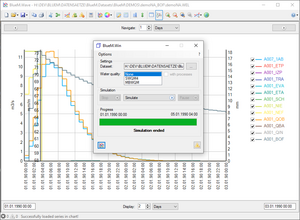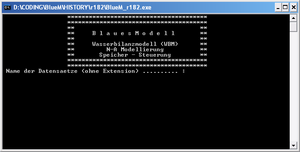BlueM.Sim application: Difference between revisions
Jump to navigation
Jump to search
mNo edit summary |
No edit summary |
||
| Line 1: | Line 1: | ||
__NOTOC__ | __NOTOC__ | ||
{{BlueM_nav}} | {{BlueM_nav}} | ||
This page is an aid to the application of BlueM. | |||
== | ==Record== | ||
* | * A record consists of several text files. Mandatory for each simulation are [[TSIM.ALL|ALL]]- (general information) and the [[TSIM.SYS|SYS]] file - (System Plan). Furthermore, files for a description of the system elements should be in the required manner. All files must have the same file name (name = record), only the file extensions differ. <small>(The name of the record shall consist of not more than 32 characters! ''See Bug 13'')</small> | ||
* | * It is possible to make a record using [[TALSIM]], after creating these can be exported and used for BlueM. These are minor modifications to the export files. See [[TALSIM Export]]. | ||
'' | ''See also [[BlueM Eingabedateien|Input files]]'' | ||
==Simulation== | ==Simulation== | ||
[[Bild:BlueMWin_screenshot.png|thumb|BlueM.Win Screenshot]] | [[Bild:BlueMWin_screenshot.png|thumb|BlueM.Win Screenshot]] | ||
=== | ===Release 0.9.1=== | ||
For individual simulations, it is easiest to use the '''[[BlueM.Win]]''' package. | |||
* | * [[BlueM Downloads|Download]] the prebuilt package <code>BlueM.Win.zip</code> and unzip. | ||
* | * Start the file <code>BlueM.Win.exe</code> | ||
* | * Select a record | ||
* | * Start simulation | ||
* | * After successful simulation, view the simulation result in BlueM.Wave. | ||
For <code>bluem.dll</code> from another application address, the [[BlueM.DLLAdapter]] can be used.<br clear="all"/> | |||
===Release 0.9=== | ===Release 0.9=== | ||
[[Bild:BlueMExe_screenshot.png|thumb|BlueM.exe Screenshot]] | [[Bild:BlueMExe_screenshot.png|thumb|BlueM.exe Screenshot]] | ||
* | * In the simplest case the compiled EXE file ([[BlueM Downloads|BlueM.exe]]) is in the same directory as the data to be simulated. In this case, simply launch the EXE at the request of the record name. Then the simulation starts. | ||
* | * You can specify the name of the data directly as a parameter to pass to BlueM.exe | ||
:<dos>C:\Arbeitsverzeichnis>"Pfad\zu\BlueM.exe" Datensatzname</dos> | :<dos>C:\Arbeitsverzeichnis>"Pfad\zu\BlueM.exe" Datensatzname</dos> | ||
* | * To prevent the window from closing immediately when the simulation is finished or an error has occurred, a shortcut to BlueM.exe can be created. In the properties of the shortcut enter the following "target" : | ||
:<pre>cmd.exe /K "Pfad\zu\BlueM.exe"</pre> | :<pre>cmd.exe /K "Pfad\zu\BlueM.exe"</pre> | ||
: | :Under "Start in" the working directory must be specified, i.e., the directory in which the record is located. | ||
== | ==Results== | ||
* | * Depending on the setting BlueM creates result files. By default, the [[WEL-file]]. | ||
'' | ''See also [[BlueM Ausgabedateien|output files]]'' | ||
=== | ===Errors / warnings=== | ||
* In | * In some cases, the blue model for a global program termination gives an '''[[ERROR-Konstanten | ERROR-Constant]]''' back. (In case a '''[[$FEHL.TMP]]''' file is generated, there is also the ERROR constant in the left column). | ||
* | * Warnings (eg, Buffer overflows) are written during the simulation in the file '''[[$WARN.TMP]]''' . | ||
[[Kategorie:BlueM.Sim Anwendung|A]] | [[Kategorie:BlueM.Sim Anwendung|A]] | ||
Revision as of 04:11, 13 May 2009
![]() BlueM.Sim | Downloads | Application | Theory | Development
BlueM.Sim | Downloads | Application | Theory | Development
This page is an aid to the application of BlueM.
Record
- A record consists of several text files. Mandatory for each simulation are ALL- (general information) and the SYS file - (System Plan). Furthermore, files for a description of the system elements should be in the required manner. All files must have the same file name (name = record), only the file extensions differ. (The name of the record shall consist of not more than 32 characters! See Bug 13)
- It is possible to make a record using TALSIM, after creating these can be exported and used for BlueM. These are minor modifications to the export files. See TALSIM Export.
See also Input files
Simulation
Release 0.9.1
For individual simulations, it is easiest to use the BlueM.Win package.
- Download the prebuilt package
BlueM.Win.zipand unzip. - Start the file
BlueM.Win.exe - Select a record
- Start simulation
- After successful simulation, view the simulation result in BlueM.Wave.
For bluem.dll from another application address, the BlueM.DLLAdapter can be used.
Release 0.9
- In the simplest case the compiled EXE file (BlueM.exe) is in the same directory as the data to be simulated. In this case, simply launch the EXE at the request of the record name. Then the simulation starts.
- You can specify the name of the data directly as a parameter to pass to BlueM.exe
- <dos>C:\Arbeitsverzeichnis>"Pfad\zu\BlueM.exe" Datensatzname</dos>
- To prevent the window from closing immediately when the simulation is finished or an error has occurred, a shortcut to BlueM.exe can be created. In the properties of the shortcut enter the following "target" :
cmd.exe /K "Pfad\zu\BlueM.exe"
- Under "Start in" the working directory must be specified, i.e., the directory in which the record is located.
Results
- Depending on the setting BlueM creates result files. By default, the WEL-file.
See also output files
Errors / warnings
- In some cases, the blue model for a global program termination gives an ERROR-Constant back. (In case a $FEHL.TMP file is generated, there is also the ERROR constant in the left column).
- Warnings (eg, Buffer overflows) are written during the simulation in the file $WARN.TMP .

